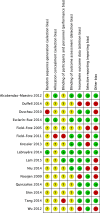Walking speed is not the best outcome to evaluate the effect of robotic assisted gait training in people with motor incomplete Spinal Cord Injury: A Systematic Review with meta-analysis
- PMID: 29065788
- PMCID: PMC6419626
- DOI: 10.1080/10790268.2017.1390644
Walking speed is not the best outcome to evaluate the effect of robotic assisted gait training in people with motor incomplete Spinal Cord Injury: A Systematic Review with meta-analysis
Abstract
Context: While there are previous systematic reviews on the effectiveness of the use of robotic-assisted gait training (RAGT) in people with spinal cord injuries (SCI), as this is a dynamic field, new studies have been produced that are now incorporated on this systematic review (SR) with meta-analysis, updating the available evidence on this area.
Objective: To synthesise the available evidence on the use of RAGT, to improve gait, strength and functioning.
Methods: SR and meta-analysis following the Cochrane Handbook for Systematic Reviews of Interventions were implemented. Cochrane Injuries Group Specialized Register, PubMed, MEDLINE, EMBASE, CINAHL, ISIWeb of Science (SCIEXPANDED) databases were reviewed for the period 1990 to December 2016. Three researchers independently identified and categorized trials; 293 studies were identified, 273 eliminated; remaining 15 randomized clinical trials (RCT) and five SR. Six studies had available data for meta-analysis (222 participants).
Results: The pooled mean demonstrated a beneficial effect of RAGT for WISCI, FIM-L and LEMS (3.01, 2.74 and 1.95 respectively), and no effect for speed.
Conclusions: The results show a positive effect in the use of RAGT. However, this should be taken carefully due to heterogeneity of the studies, small samples and identified limitations of some of the included trials. These results highlight the relevance of implementing a well-designed multicenter RCT powered enough to evaluate different RAGT approaches.
Keywords: Spinal cord injuries; locomotor training; robot-assisted gait training; robotics; walking.
Figures







Similar articles
-
Effects of Robot-Assisted Gait Training in Individuals with Spinal Cord Injury: A Meta-analysis.Biomed Res Int. 2020 Mar 21;2020:2102785. doi: 10.1155/2020/2102785. eCollection 2020. Biomed Res Int. 2020. PMID: 32280681 Free PMC article. Review.
-
Effect of robotic-assisted gait training on gait and motor function in spinal cord injury: a protocol of a systematic review with meta-analysis.BMJ Open. 2023 Sep 22;13(9):e070675. doi: 10.1136/bmjopen-2022-070675. BMJ Open. 2023. PMID: 37739462 Free PMC article.
-
Gait training using a wearable robotic hip device for incomplete spinal cord injury: A preliminary study.J Spinal Cord Med. 2025 Mar;48(2):208-220. doi: 10.1080/10790268.2023.2273587. Epub 2023 Nov 7. J Spinal Cord Med. 2025. PMID: 37934493 Free PMC article.
-
Robotic-Assisted Gait Training Effect on Function and Gait Speed in Subacute and Chronic Stroke Population: A Systematic Review and Meta-Analysis of Randomized Controlled Trials.Eur Neurol. 2019;81(3-4):103-111. doi: 10.1159/000500747. Epub 2019 Jun 5. Eur Neurol. 2019. PMID: 31167193
-
Effects of robot-assisted gait training on cardiopulmonary function and lower extremity strength in individuals with spinal cord injury: A systematic review and meta-analysis.J Spinal Cord Med. 2024 Jan;47(1):6-14. doi: 10.1080/10790268.2023.2188392. Epub 2023 Mar 27. J Spinal Cord Med. 2024. PMID: 36972206 Free PMC article.
Cited by
-
Comparison of Walking Quality Variables between End-Stage Osteonecrosis of Femoral Head Patients and Healthy Subjects by a Footscan Plantar Pressure System.Medicina (Kaunas). 2022 Dec 28;59(1):59. doi: 10.3390/medicina59010059. Medicina (Kaunas). 2022. PMID: 36676683 Free PMC article.
-
Traumatic spinal cord injury: a review of the current state of art and future directions - what do we know and where are we going?N Am Spine Soc J. 2025 Mar 5;22:100601. doi: 10.1016/j.xnsj.2025.100601. eCollection 2025 Jun. N Am Spine Soc J. 2025. PMID: 40256049 Free PMC article.
-
Comparison of walking quality variables between incomplete spinal cord injury patients and healthy subjects by using a footscan plantar pressure system.Neural Regen Res. 2019 Feb;14(2):354-360. doi: 10.4103/1673-5374.244798. Neural Regen Res. 2019. PMID: 30531020 Free PMC article.
-
The effect of robot-assisted gait training for patients with spinal cord injury: a systematic review and meta-analysis.Front Neurosci. 2023 Aug 22;17:1252651. doi: 10.3389/fnins.2023.1252651. eCollection 2023. Front Neurosci. 2023. PMID: 37680972 Free PMC article.
-
Comparison of Efficacy of Lokomat and Wearable Exoskeleton-Assisted Gait Training in People With Spinal Cord Injury: A Systematic Review and Network Meta-Analysis.Front Neurol. 2022 Apr 13;13:772660. doi: 10.3389/fneur.2022.772660. eCollection 2022. Front Neurol. 2022. PMID: 35493806 Free PMC article.
References
-
- Mehrholz J, Kugler J, Pohl M.. Locomotor training for walking after spinal cord injury (Review) Locomotor training for walking after spinal cord injury. Cochrane Collab 2012;(11):1–49.
-
- Lyalka VF, Zelenin P V, Karayannidou A, Orlovsky GN, Grillner S, Deliagina TG.. Impairment and recovery of postural control in rabbits with spinal cord lesions. J Neurophysiol 2005;94(6):3677–90. - PubMed
-
- Quinzaños J, Villa A R, Flores A, Pérez R.. Proposal and validation of a clinical trunk control test in individuals with spinal cord injury. Spinal Cord 2014;52(6):449–54. - PubMed
-
- Behrman AL, Harkema SJ.. Locomotor Training After Human Spinal Cord Injury: A Series of Case Studies. J Am Phys Ther Assoc 2000;80(7):688–700. - PubMed
Publication types
MeSH terms
LinkOut - more resources
Full Text Sources
Other Literature Sources
Medical
Research Materials
